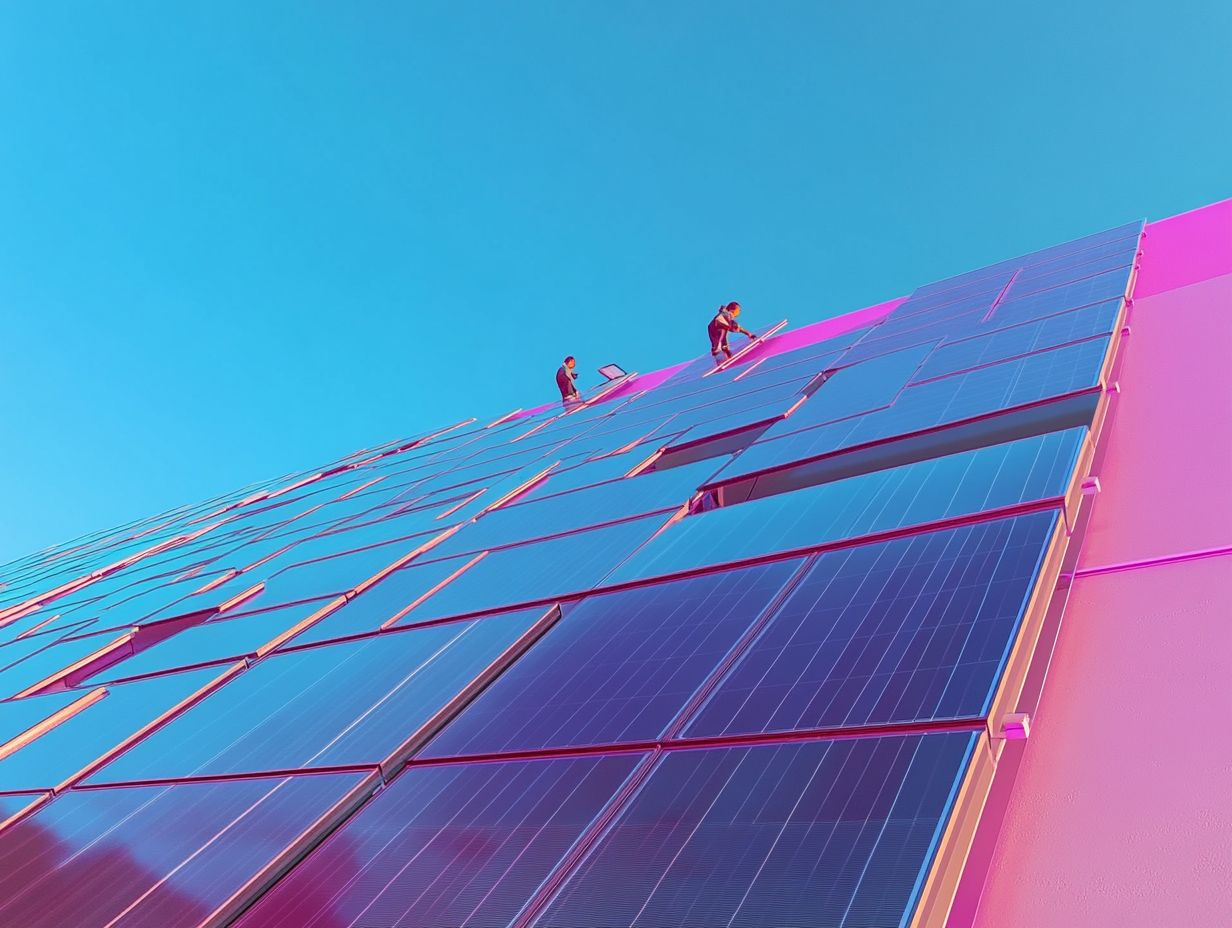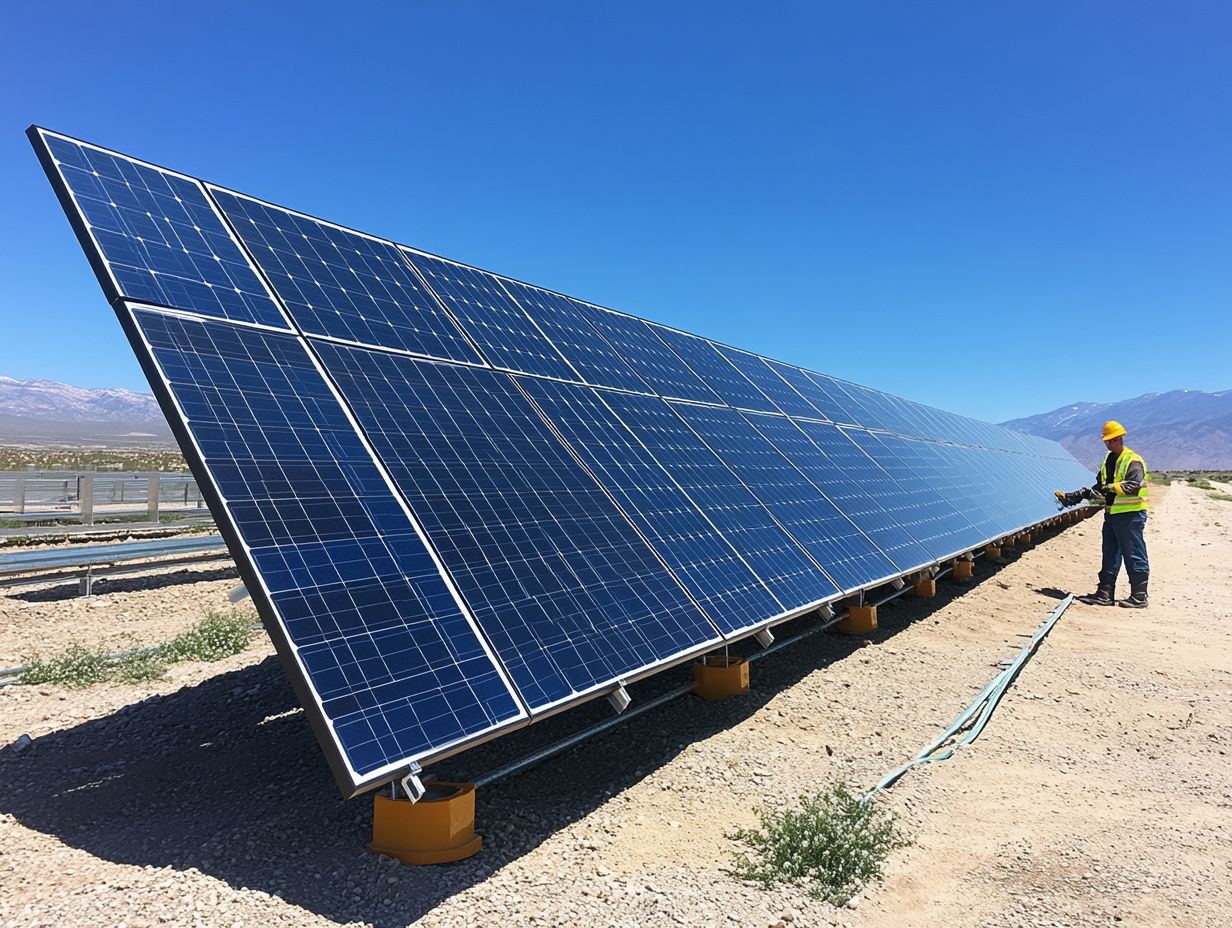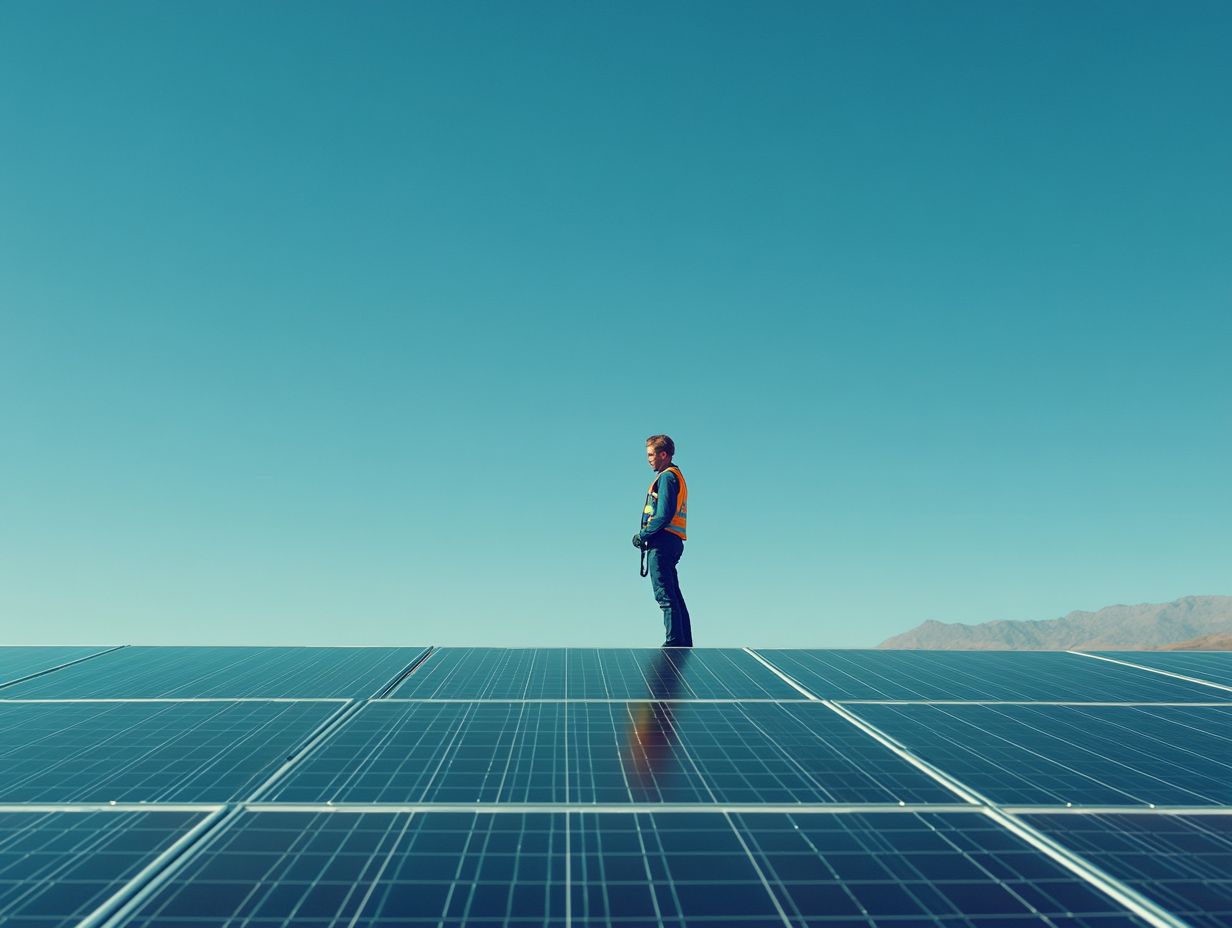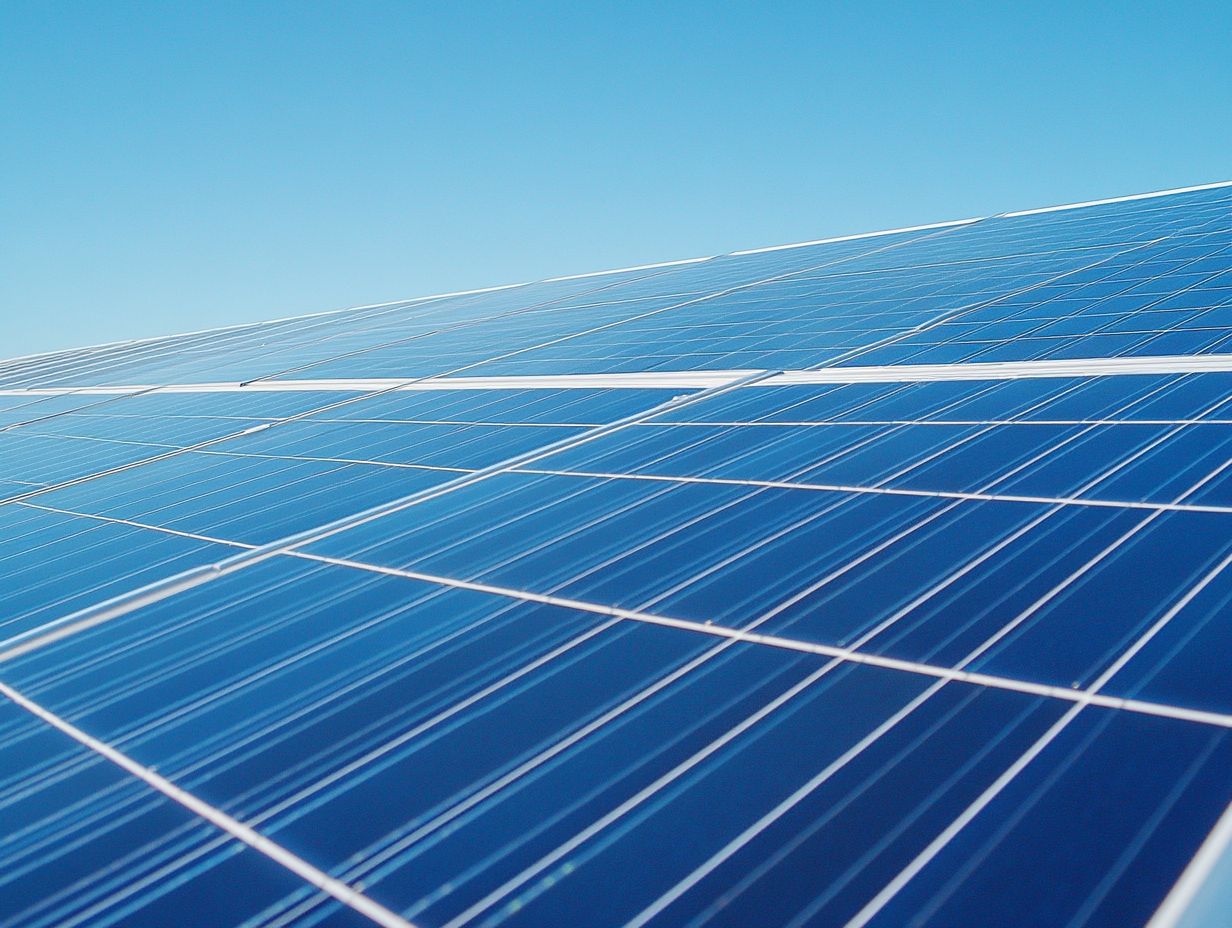Contents
- 1 An overview of solar panels and their functionality.
- 2 Components of Solar Panels
- 3 Different Types of Solar Panels
- 4 Maintenance of Solar Panels
- 5 Maximizing the Lifespan of Solar Panels
- 6 Solar Panel Maintenance: Frequently Asked Questions
- 6.1 What are the main components of a solar panel?
- 6.2 What is the role of an inverter in solar panel maintenance?
- 6.3 How often should solar panels be cleaned and maintained?
- 6.4 What are the signs that a solar panel requires maintenance or repair?
- 6.5 Can solar panels be easily repaired if they become damaged?
- 6.6 What is the average lifespan of a solar panel?
Solar panels, utilizing photovoltaic cells, are a great way for you to harness solar energy and provide renewable power for your home or business.
In this article, you’ll explore the essential components of solar panels, including solar inverters and battery storage, highlighting the key parts that help them work effectively. You’ll also dive into the various types of solar panels available, learn about their specific applications, and understand the importance of regular maintenance and inspections to keep them running smoothly.
Get ready to discover practical tips for maximizing the lifespan and performance of your solar investment, including energy efficiency strategies and degradation prevention, so you can really make the most of this renewable energy source.
An overview of solar panels and their functionality.

Solar panels, or commonly known as photovoltaic modules, are pretty amazing devices that turn sunlight into usable electricity. They’re becoming a big deal in the renewable energy world.
With everyone focusing more on sustainability and cutting down on environmental impact, solar energy is a top pick for both homes and businesses looking to generate power.
By capturing solar energy through solar power systems, you can not only save on your energy bills but also do your part for a greener planet. And as technology keeps advancing, these solar panels are getting even better, producing more energy while still being friendly to the environment and helping you gain energy independence.
Components of Solar Panels
The components of solar panels are super important for how well your solar energy system performs. Each part, from the solar cells that catch the sunlight to the inverters that turn it into usable electricity, is designed to work together and maximize energy output.
The mounting systems give your panels stability and protect them from the weather, while the wiring and junction boxes are crucial for making safe electrical connections.
By understanding these components, you can optimize your solar panel efficiency and ensure reliable energy production.
Luque, A., & Hegedus, S. (2011). Handbook of photovoltaic science and engineering. John Wiley & Sons. Link
Key Components and Their Functions
The key parts of solar panels include solar cells, inverters, and battery storage systems, and each of these plays a crucial role in how you generate and manage energy.
Solar cells, made from semiconductor materials, capture sunlight and generate direct current (DC) electricity. Then, inverters step in to convert that electricity into alternating current (AC) for use in your home or business.
Battery storage systems are your backup plan, storing any extra energy for later use, which means you’ll have a consistent energy supply even when the sun isn’t shining. Proper wiring and junction boxes make sure everything connects safely and efficiently.
Think of solar cells as the heart of your system, turning sunlight into electrical energy through the photovoltaic effect. Solar inverters are the critical link that transforms that DC electricity into AC, making it friendly for all your household appliances.
By integrating battery management systems, you can manage your energy flow effectively, storing up surplus power generated during those sunny peak hours for use when you really need it or during outages.
To get the most out of your solar setup, you’ll want to keep those panels clean, utilize maintenance tools, use maximum power point tracking (MPPT) techniques, and ensure your system is properly sized. These strategies can significantly boost your efficiency and reliability.
Understanding how all these components interact is key to maximizing your energy production and keeping costs down.
Different Types of Solar Panels
When you’re diving into solar panels, you’ll find a variety of types and module designs, each with its own unique perks based on efficiency and what you plan to use them for.
The big players are monocrystalline, polycrystalline, and thin-film panels.
Here are the main types:
- Monocrystalline panels are your go-to for high efficiency and saving space.
- Polycrystalline panels give you a more budget-friendly option without sacrificing too much efficiency.
- If you’re looking for something flexible and lightweight, thin-film panels are perfect for those unconventional setups.
By understanding these types and how they perform in different conditions—like shading and thermal performance—you can make a more informed choice for your solar installation.
Various Technologies and Their Applications

Different solar technologies, like microinverters and string inverters, can really impact the energy yield, efficiency ratings, and overall performance of your solar power system.
It’s important for you to understand these technologies so you can optimize your energy production based on your specific environmental conditions and energy consumption needs. Besides microinverters and string inverters, other systems such as power optimizers and central inverters also play crucial roles in modern solar setups.
Power optimizers work alongside string inverters to get the most out of each panel, while central inverters might be a more economical choice for larger installations.
If you’re a homeowner or a business thinking about going solar, evaluating the unique features of each technology, including their efficiency ratings and energy conversion capabilities, can make a big difference in your energy independence, cost savings, and ROI (return on investment). Taking the time to carefully choose the right solutions will help you meet your specific energy demands perfectly.
Maintenance of Solar Panels
Keeping your solar panels well-maintained is key to making sure they last a long time and perform at their best. Regular cleaning, like rinsing off debris and washing the panels, can really boost their efficiency by reducing shading and letting in as much sunlight as possible.
Additionally, setting up a maintenance schedule that includes routine inspections can help you spot any potential issues before they turn into expensive repairs. By using effective troubleshooting, diagnostic tools, and repair techniques, you can enhance your solar energy system’s lifespan and make the most out of your investment.
Regular Cleaning and Inspection
Regularly cleaning and inspecting your solar panels is key to keeping them efficient, ensuring optimal energy output, and ensuring they perform well in the long run. Simple cleaning techniques, like using a soft brush or a water spray, can help you get rid of dirt, dust, and debris that pile up on the surface, preserving their panel efficiency and boosting energy output.
Additionally, setting up a maintenance schedule for routine inspections helps you catch any signs of wear and tear or issues that could impact power generation. These steps are extremely important for optimizing performance and extending the lifespan of your solar energy system.
On top of those basic cleaning methods, using a mild soap and water solution can really enhance your cleaning efforts, especially in spots that attract bird droppings or tree sap.
It’s also a good idea to check the installation angle and make sure there aren’t any overhanging trees or structures casting shadows on the panels. Shading can seriously cut down on energy output.
Implementing a seasonal cleaning routine, ideally during the cooler early morning or late evening hours, can help you avoid heat-related damage and ensure a more thorough clean.
It is important to prioritize quality—hiring service providers for annual check-ups can add an extra layer of protection and maintenance, helping to make sure your solar system runs at peak performance with optimal output performance all year round.
Common Issues and How to Address Them
Common issues with solar panels include performance degradation, shading effects, and electrical connection problems, all of which can significantly impact energy loss and put a damper on your energy production. Troubleshooting these problems starts with regular inspections to spot any signs of wear or damage.
It may be tempting to overlook these complications, but addressing them promptly is key. Performance degradation could be caused by dirt buildup or aging components, and it’s often more than just a simple cleaning job.
If you have nearby trees or buildings casting shade on your panels, that can significantly cut into your output. So, it’s extremely important to conduct a site assessment to determine where you place your solar panels and to keep any obstructive vegetation trimmed back.
Electrical connection issues can arise from loose or corroded terminals, so you’ll want to take a close look at the wiring and connectors to ensure corrosion resistance. Effective repair techniques involve methodically testing voltage levels and securing those connections to prevent further headaches.
And don’t skimp on quality—using top-notch replacement parts not only helps ensure your system lasts longer but also boosts energy efficiency, which is crucial for saving money in the long run.
Maximizing the Lifespan of Solar Panels

Maximizing the lifespan of your solar panels is all about a mix of proactive maintenance and smart usage strategies to fight off degradation over time. Effective maintenance is crucial for ensuring optimal performance and longevity of your solar energy system.
By setting up a routine maintenance schedule, using effective cleaning techniques, and optimizing the tilt angle and panel orientation, you can significantly boost their performance. Plus, keeping an eye on environmental factors like shading and climate effects will help your solar energy system last longer.
These practices not only support environmental sustainability but also help you enjoy energy independence and economic benefits for years to come.
Essential Tips for Long-Term Solar Panel Performance
To keep your solar panels performing well over the long haul, it’s crucial to follow a solid maintenance checklist that includes regular inspections and cleaning. Keeping an eye on energy output can give you valuable insights into how efficiently your panels are working and help you spot any potential issues before they become major problems.
You might also want to think about making some system design tweaks, like adjusting the tilt angle for the best sunlight exposure and reducing shading effects. These proactive steps, including shading analysis and energy audits, can really boost the lifespan and efficiency of your solar energy system.
When you do your regular inspections, don’t just check the surface of the panels. Make sure to look at the wiring, inverters, and electrical connections, since these parts can have a big impact on performance and energy efficiency. Pay attention to seasonal changes, too, as they can help you adjust and keep your system running optimally throughout the year, considering factors like sunlight exposure and weather resistance.
Using performance monitoring systems can also help you track performance metrics in real-time, allowing you to make timely interventions if needed. By understanding your system’s requirements, including energy output and efficiency ratings, and sticking to these best practices, you can ensure that your solar panels, part of your broader solar power systems, keep delivering maximum benefits for years to come. Popular performance monitoring systems like SolarEdge and Enphase can help you monitor your system effectively.
Solar Panel Maintenance: Frequently Asked Questions
What are the main components of a solar panel?
The main components of a solar panel include photovoltaic (PV) cells, a frame, a glass cover, and wiring. PV cells are responsible for converting sunlight into electricity, a fundamental aspect of solar energy generation, while the frame and glass cover ensure weather resistance and protect the cells from external factors. The wiring facilitates energy conversion by connecting the solar panel to other components of a solar power system, including solar inverters and battery storage solutions.
What is the role of an inverter in solar panel maintenance?

An inverter is an essential component in a solar panel system as it converts the direct current (DC) electricity produced by the solar panel into alternating current (AC) electricity that can be used in homes or businesses. Different inverter types, such as string inverters and microinverters, offer various advantages. Regular maintenance of the inverter is necessary to ensure the efficient functioning of the solar system and to prevent energy loss.
How often should solar panels be cleaned and maintained?
Solar panels should be cleaned and maintained at least once a year to remove any dirt, debris, or snow that may accumulate on the surface, affecting energy output. In areas with high levels of dust or pollution, more frequent cleaning may be necessary. Regular maintenance should also be conducted to check for any damage, degradation, or defects in the components, ensuring optimal panel efficiency and environmental sustainability.
What are the signs that a solar panel requires maintenance or repair?
Some signs that a solar panel requires maintenance or repair include a decrease in electricity production, physical damage to the panels, and loose or damaged wiring. If you notice any of these signs, it is important to conduct a thorough inspection and contact a professional for repairs if necessary. Note that professional repairs may incur costs that vary depending on the extent of the damage.
Can solar panels be easily repaired if they become damaged?
In most cases, solar panels can be easily repaired if they become damaged. However, it is important to note that attempting to repair solar panels on your own can be dangerous and may void any warranties. It is best to contact a professional to properly assess and repair any damages to ensure the safety and functionality of the solar system.
What is the average lifespan of a solar panel?
The average lifespan of a solar panel is around 25 years. However, this can be extended with proper maintenance and care. Regularly inspecting and maintaining your solar panels is crucial for checking for corrosion resistance and evaluating warranties, to ensure their longevity and optimal performance, maximizing your return on investment (ROI).
Masters, G. M. (2004). Renewable and efficient electric power systems. John Wiley & Sons. Link

